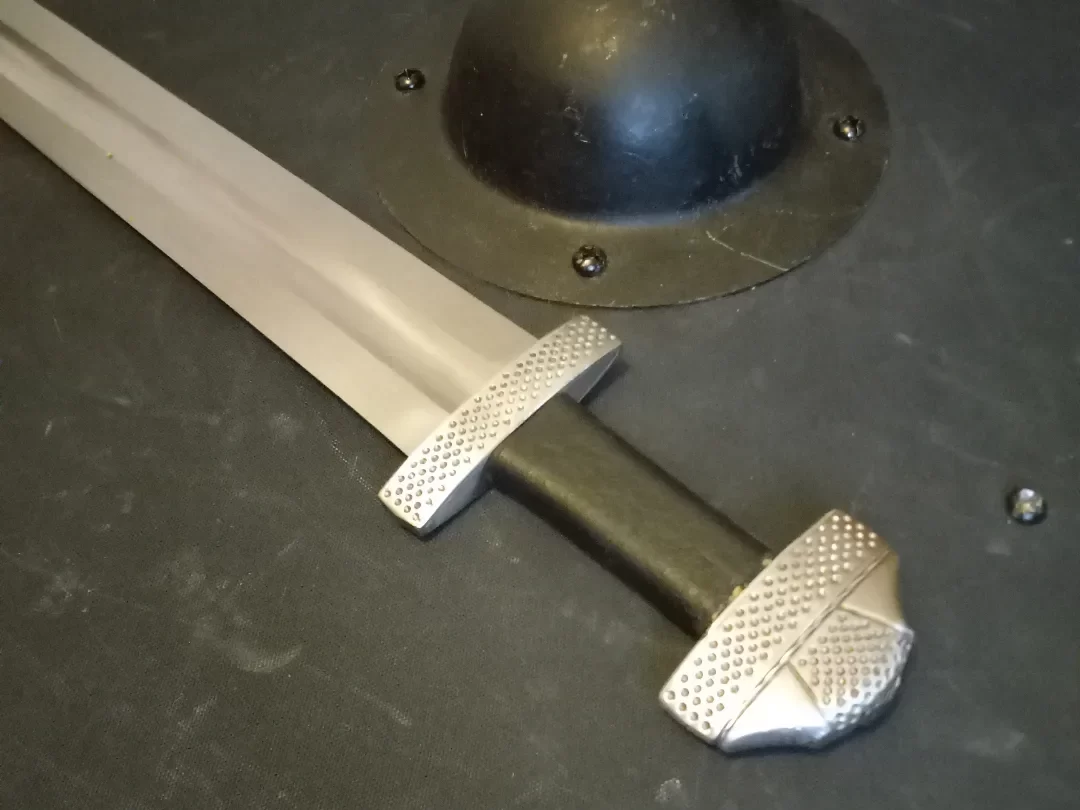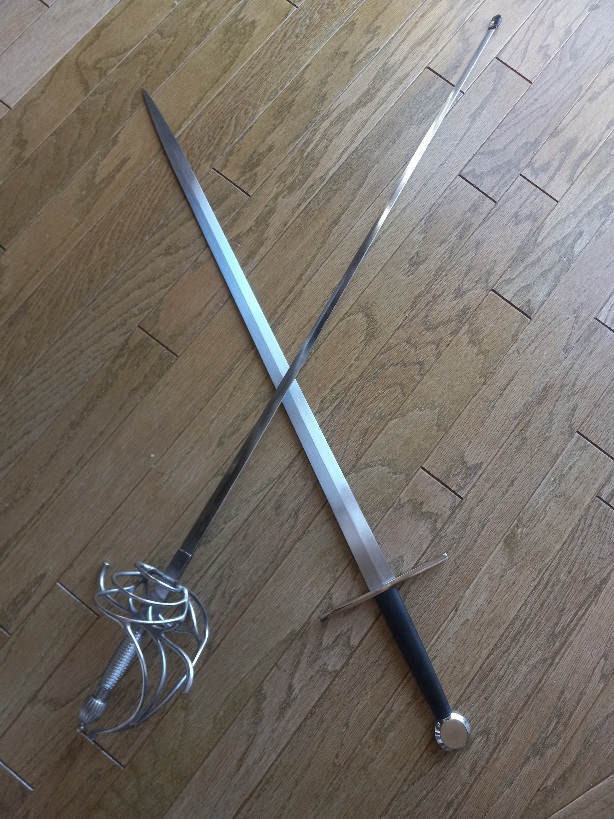Your cart is currently empty!

HEMA Tournaments: What do They Fight For?
Like all sports, competitiveness comes into play somewhere…
In my last video, I talked about the Noble Science Academy, which is one of many Historical European Martial Arts (HEMA) schools around the world. These fencing schools don’t teach the usual fencing that comes to mind when people hear the word “fencing,” often conjuring up images of people in white bodysuits tagging each other with skinny, floppy swords at grand events like the Olympics. That form of fencing is referred to as Olympic fencing, and is a very challenging sport with very skilled practitioners, but quite different from HEMA.
HEMA is different from Olympic fencing in that the historical component is what the sport aims to showcase. HEMA practitioners go to great lengths to dig up historical fencing manuals from the renaissance era or earlier to copy the techniques taught by the sword masters of old. According to Noble Science Academy fencer Zack Johnson, sport fencing has distanced itself from HEMA. “It has distanced itself from being a lethal art into being something that you would do for fun, while HEMA attempts to maintain both a historical connection back to the sources […] HEMA also makes an effort to simulate duels where there [is] blood loss and consequences versus sport fencing which is all about the points.”
Rather than using skinny fencing foils, many of these manuals instruct readers on how to use a wide variety of weapons. Some of the most common weapons in HEMA are the longsword, rapier, and saber. The longsword is a large, straight two-handed double-edged sword, and is perhaps the primary weapon of HEMA practitioners. Another favorite is the rapier. A personal favorite of mine, rapiers have long, slender blades with an elegant hilt or cup to protect the user’s hand. These swords were carried by civilians for self defense and dueling. Lastly there is saber, which comes in many different varieties. What sabers all have in common is that they are single handed and have curved blades, often being used by troops mounted on horseback and military officers. Longswords will be the primary focus of this article.

Now that you are familiar with a few of the weapons used by HEMA practitioners, you might be asking what they do with all their training, since some of the more hardcore members are keen to practice nearly every day. The answer is simple: tournaments. There is one thing you should understand first, and it is that HEMA tournaments are not funded or owned by some big corporate overseers the same way professional sports leagues are. They are far more community based, and different tournaments may have slightly different rules from each other. Generally, volunteers organize the tournaments and rent out spaces in small events centers in different cities. Larger venues are sometimes rented out for larger tournaments. People who often participate in tournaments or wish to, keep close track of upcoming events through online event trackers made by passionate HEMA community members.
Ryan Renfro of the Noble Science Academy of Sparks, Nevada, can shine some additional light on what goes into tournaments.
Don’t underestimate the lengths some practitioners will go to in order to chase the online clout of HEMA ratings. Personally, I know some fencers that train at the academy several times a week, and have suffered serious injuries during their training, including a broken femur. There are others that will travel several states over to attend the next tournament instead of waiting for a more local one to come their way. Others are far more casual, and aren’t that interested in fighting in tournaments, but rather like fencing for the sake of it, and perfecting the historical fighting styles. For them, the history that is associated with the sport instead of its competitiveness is the greatest appeal. I myself think that I fall into this camp, however I will soon try my hand at the next local tournament for the rapier duels.
When attending a tournament, whether to participate or just spectate, it is important to understand the scoring system. It is also worth noting that the scoring system will be different depending on what weapon the fencers are using (both fencers in competition will be using the same weapons however). For example, the scoring system for longswords may be different from the scoring system in a rapier competition. For the sake of simplicity, I will be talking about longsword.
There are two types of target areas on the body in which points can be scored. High priority and low priority targets. High priority targets are worth the most points, and include the head, shoulders, and torso. This is where the most vital organs are, and them being worth the most points is to encourage fencers to actually score what would be considered lethal hits (in a real duel) rather than just striking easier targets. Low priority areas that are worth the least amount of points when hit are anything below the elbows and below the torso.
Women’s champion longsword fencer Raschelle Debolt gives a good overview of the scoring system, as well as her experience with HEMA competitions.
Now you have heard the basics of what tournaments are, why people go to them, and what the rules are. What you have not seen however is an actual tournament duel. Unfortunately, you will not see one in this article, because the next one is scheduled for the spring. What you will see, however, is a recreation of a longsword tournament duel. I asked the fencers of the Noble Science Academy if they would be gracious enough to put on a mock tournament duel using the same rules as a real tournament, and they were happy to oblige.
You will notice that there are two fencers. One fencer is labeled as the red fencer and the other is the black fencer. The color of their outfits may speak for themselves, but in a real tournament where two contestants might be wearing the same color, or a color that is neither red nor black, a handkerchief of the appropriate color is worn on the belt of each fencer denoting to the judges and audience which one is the red or black fencer. This is important when assigning points, as often the judge will assign points to “red fencer” or “black fencer” using callouts. In the video, you may notice that there is only one judge, in this case Raschelle. In a tournament, there may be a couple more judges watching the duel from different angles, as hits can happen so fast that they might be missed by a judge who cannot observe every possible angle at once.
One thing you may have noticed is that a majority of the hits in the video were low-priority shots to the arms or hands. This is worth mentioning because it is something that people who are unaccustomed to fencing often find surprising. Hits to the hands are jokingly referred to as hand-snipes. The hands of a fencer provide easy targets, as they are usually the first things within reach of your opponent’s blade. The crossguard of the longsword does not provide complete hand protection, and it is very easy to neglect protecting your hands during the heat of an exchange. A shot to the hands, while seeming like a cheap shot, is still a perfectly valid way to score points on your opponent. This is to ensure that HEMA maintains its roots as a lethal martial art from the medieval and renaissance era as previously explained by Zack, when a hit to the hands could have easily removed them with a real sword.
As explained by Raschelle, the swords of the duelists in the mock longsword match also had to strike from a 45 degree rotation to ensure that the blade theoretically had enough momentum and energy to deliver a deadly blow, as another example of the martial past of HEMA and how it seeks to differentiate itself from sport fencing, where a light tag from a floppy fencing foil still delivers a point. This more “hardcore” aspect of HEMA is also why the fencers wear much more protection than normal Olympic fencers. The heavy fencing jacket, known as a gambeson, is the primary layer of defense. HEMAists who spar with steel swords (which are of course blunted) also wear sturdy arm guards and gauntlets made from overlapping hard plastic pieces on top of their gambesons to soften any blows and prevent broken fingers. Armor pieces like these would have been present during the historical periods HEMA seeks to emulate, however in modern HEMA tournaments, the armor is simply there for the safety of the fencers. The presence of armor does not nullify any points made on a duelist during a tournament, as their purpose is to show off the skill of the fencers, and not how much money they spent on complete armor coverage. For that reason, HEMA seeks to emulate unarmored combat, especially in competitions.
HEMA is still a very niche sport, but it is steadily growing. Some seek it out due to being fans of fantasy media that heavily features swords. Others seek it out due to the community and historical aspects, and are infatuated with the time period it draws material from. No matter what the reason for choosing HEMA may be, many new practitioners are eventually drawn into the tournament scene, whether through peer pressure from their local club or genuine curiosity about their own fencing abilities. Even if you are not a HEMA practitioner and are reading this, it is my hope that you now have a better understanding of the tournament scene of the HEMA community, as arguably it is the biggest and most talked about part of its community. If you are a HEMA practitioner, then it is my hope that you walked away with a little more understanding of tournaments, and may even be more inspired to participate yourself!
